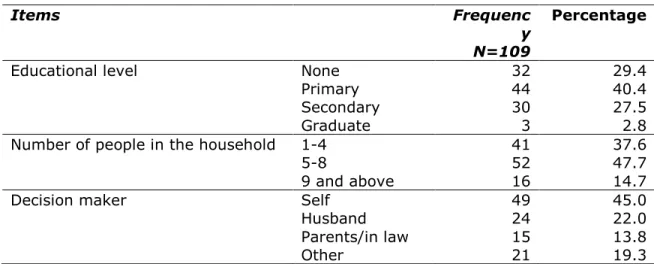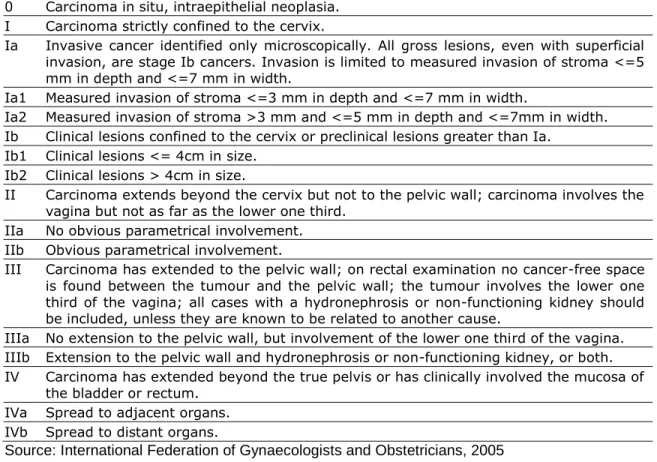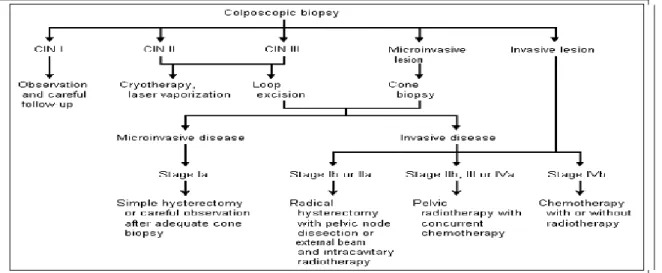The cervical cancer patients from Gray's Hospital who used to be interviewed about their health-seeking behavior in relation to their current condition. According to the Program for Applied Technology in Health (PATH), global statistics show that nearly half a million new cases of invasive cervical cancer are diagnosed each year. The overall aim of this research was to determine the patterns of health-seeking behavior of women being treated for cervical cancer.
All patients treated for cervical cancer within the study period who gave informed consent to their participation in the study were enrolled. The variables that most influenced health-seeking behavior and that still remained statistically associated with the outcome variables under the multivariate analysis were found to be age, marital status, employment status, social support for medical care, education level, knowledge of Pap smear screening, and recognition of cervical cancer. The study achieved its objective of determining the patterns of health-seeking behavior in women treated for cervical cancer at Grey's Hospital.
All recommendations must be considered by the Ministry of Health and relevant authorities in South Africa to minimize the spread of cervical cancer.
BACKGROUND
- Introduction
- Problem Statement
- Scope of the Study
- Research Aim and Objectives
- Overview of Research Report
Human papillomavirus (HPV) infection is a necessary factor in the development of almost all cases of cervical cancer. The study by Waktola et al., (2005) found that cervical cancer generally takes many years to develop. Walker et al., (2002) found that most women with a diagnosis of cervical cancer either did not have regular
Imperfections in the types of health care choices or treatment measures that women with cervical cancer symptoms seek. Programs will be most effective if they are based on local assessments of: a) The epidemiology of cervical cancer in the population; The overall aim of this study is to determine the patterns of health-seeking behavior of women treated for cervical cancer.
Chapter two presents a review of the literature covering the natural history of cervical cancer, the objectives of cervical screening programmes, the burden of the disease worldwide and in South Africa, the presentation of the disease, risk factors and management of cervical cancer and the Health Seeking Behavior Model in relation to screening and early detection of cervical cancer.

LITERATURE REVIEW
- Introduction
- The Epidemiology of Cervical Cancer
- Burden of cervical cancer
- In the Developed World
- In the Developing World
- In South Africa
- Risk Factors Associated with Cervical Cancer
- Cervical cancer in women living with HIV
- Clinical Presentation
- Stage Characteristics
- Prevention and Management of Cervical Cancer
- Prevention perspective
- Curative Perspective
- Prognosis
- Health Seeking Behaviour
- Factors influencing health seeking behaviour
- Knowledge and Health Seeking Behaviour
- Recognition of symptom and health seeking behaviour
- Age and Health Seeking Behaviour
- Socio Economic Status and Health Seeking Behaviour
- Alternative Medicine
- Conclusion
Human papillomavirus (HPV) infection is a necessary factor in the development of almost all cases of cervical cancer (Ibid.). Cervical cancer rates in Africa, particularly among black women, are among the highest in the world (Denny, 2005). Massad, et al., (2008) report that people infected with HIV are also infected with other viruses that cause certain cancers such as Human Papillomavirus (HPV) that causes cervical cancer.
Lack of knowledge affects health seeking among women with cervical cancer. A lack of knowledge about the risk factors associated with cervical cancer has contributed to this. This chapter provides an overview of the existing literature on cervical cancer and the factors that determine the health-seeking behavior of women with cervical cancer.
This study was designed to determine the type of health seeking behavior required by women presenting with cervical cancer at Gray Hospital.

RESEARCH METHODOLOGY
- Introduction
- Study Setting
- Study Design
- Study Period
- Study population
- Study Sampling Strategy and Sample Size
- Variables Measured
- Data collection
- Questionnaire Design
- Data management and data storage
- Data analysis
- Descriptive statistics on all variables
- Bivariate Analysis
- Multivariate Analysis
- Mechanism to ensure validity and reliability of study
- Ethical Considerations
- Ethical approval and permissions
- Ethical principles supported by the study
- Limitations of the study
- Conclusion
The study protocol was submitted to the Postgraduate Education Committee (Ref: PG02/07) and full approval was granted on 5 June 2009 (Appendix 1.1). Permission to conduct the study at Gray's Hospital was sought from the hospital manager and was obtained on 24 March 2009 (Appendix 1.4). The study (target) population was all women over the age of 18 who were treated for cervical cancer at Gray's Hospital in 2009.
All cervical patients receiving treatment were eligible to participate in the study as the duration of treatment is usually for 6 weeks. All patients treated for cervical cancer within the study period, June–August 2009, who gave informed consent for their participation in the study, were. The total number included in the study was 109 and these were determined to be sufficient for the study, as discussed with the statistician.
Only two patients were excluded due to their poor health status, which did not allow them to consent to participate in the study. The personal contact facilitated responses and quality information and also enabled respondents with low literacy levels to participate in the survey. Data will be stored in a secure location until the results of the study are published.
All patients interviewed may not have been representative of all women with cervical cancer in the districts; this would not give the real picture of the study. The study population was all women over 18 years of age receiving treatment for cervical cancer at Gray Hospital's Department of Oncology at the time of data collection. Management bias: Errors can occur in the analysis phase of the study, when data is manually obtained from questionnaires and tests.
Obligation for feedback: the results of the study will be returned to the hospital after the completion of the study. 43 For the purpose of this study, the study population consisted of all women over 18 years of age being treated for cervical cancer in the Oncology Department of Gray Hospital and also mainly patients who are in the final stage of the disease.
RESULTS
- Descriptive summary of predisposing factors
- Descriptive summary of enabling factors
- Descriptive summary of need factors
- Descriptive summary of health seeking choices
- Findings of bivariate analyses
- Analyses of outcome variable „Preferred health care provider‟
- Analyses of outcome variable „action at first symptom for current condition‟
- Analyses of outcome variable „ever had Pap smear in relation to other condition‟
- Analyses of outcome variable „age of first Pap smear‟
- Analyses of outcome variable „ever referred for Pap smear‟
- Analyses of outcome variable „diagnosis made through routine Pap smear‟
- Multivariate analysis
- Conclusion
More than half of the women only had a Pap smear once the cervical cancer symptoms were present. 52 4.5.3 ANALYZES OF OUTCOME VARIABLES 'EVER HAD PAPSMORE IN RELATION TO OTHER CONDITION' RELATION TO OTHER CONDITION'. The table below presents bivariate analyzes performed with the dependent variable "ever had Pap smear in relation to other condition" in relation to the independent variables predisposing factors, enabling factors and need factors.
Statistically significant associations with marital status, education level, employment status, and HIV status were found for "at least ever having a Pap smear in association with other diseases". Single women who have dropped out of primary school and working women are more likely to ever have a Pap smear compared to other conditions. Women with HIV are less likely to ever have a Pap smear compared to other conditions.
55 Statistically significant associations with age, education level, employment status, cancer rate and HIV status were found for 'age of first Pap smear'. Statistically significant associations with age, education level, number of people in the household, employment status, barrier to access to health care, and cancer rate were found for "always referred for a Pap smear." Women who are employed and have difficulty accessing health care are less likely to be referred for a Pap smear.
The table below shows bivariate analyzes performed with the dependent variable 'diagnosed by routine smear' in relation to the independent variables which are predisposing factors, facilitating factors and need factors. For 'diagnosed through a routine Pap smear', statistically significant associations were discovered with marital status, employment status, household decision maker, barrier to access to healthcare and knowledge of the definition of cervical cancer. Respondents who have difficulty accessing healthcare are less likely to be referred for a smear test.
Respondents who are less educated are less likely to be referred for Pap smears. 61 social support for medical treatment, educational level, knowledge of Pap smear screening and recognition of symptoms of cervical cancer.

DISCUSSION AND CONCLUSIONS
- Introduction
- Predisposing factors associated with the decision to seek care
- Enabling factors associated with decision to seek care
- Need factors associated with decision to seek care
- Health service utilization characteristics of patients being treated for cervical cancer
- Future Research
- Summary and Conclusion
Also, respondents over 50 are less likely to have had their first Pap test when they were younger, thus presenting an advanced stage of cervical cancer. Multivariate analysis shows that women who make their own decision are more likely to seek health care from other providers and less likely to be diagnosed with cervical cancer through routine Pap smear testing. Most women perceive their health status as good and have no knowledge of cervical cancer, nor do they understand or recognize the symptoms of cervical cancer.
However, the 64.2% who perceived their health status as good did not undergo a routine smear test for the early detection of cervical cancer and were never referred for it. More than half of women only undergo a smear test if the symptoms of cervical cancer are present. Nearly half of the women were HIV positive, while more than half of the women interviewed were in an advanced stage of cervical cancer.
Finally, under the multivariate analysis, the study found that respondents diagnosed with cervical cancer by routine Pap smear were more than 10 times more likely to report having knowledge of cervical cancer. It should be properly addressed to inform and educate women about cervical cancer and its prevention in others to control the spread of the disease. Further analyzes of the statistically significant outcome variables confirmed that women who made their own decisions were more likely to visit other providers rather than a health professional once they noticed the symptoms of cervical cancer.
69 social support for medical treatment, age, employment status, marital status, knowledge of cervical cancer and barriers to healthcare. Overall finding for late diagnosis of cervical cancer stems from a lack of knowledge about the condition and low uptake of screening programmes. The variables still statistically associated with the outcome variables under the multivariate analysis are women with social support for medical care, age, employment status, marital status, knowledge of cervical cancer, and barrier to health care.
The study achieved its aim to determine the health-seeking behavior patterns of women being treated for cervical cancer at Gray Hospital. Use and outcomes of cervical cancer prevention services among HIV-infected women in Cape Town.
1 Postgraduate Education Committee Approval
2 Biomedical Research Ethics Approval
3 Chief Executive Officer of Grey's Hospital Approval
4 Department of Health's Research Approval
5 Letter of permission
6 Information document
7 Informed Consent
8 Questionnaire to patient
9 Checklists






